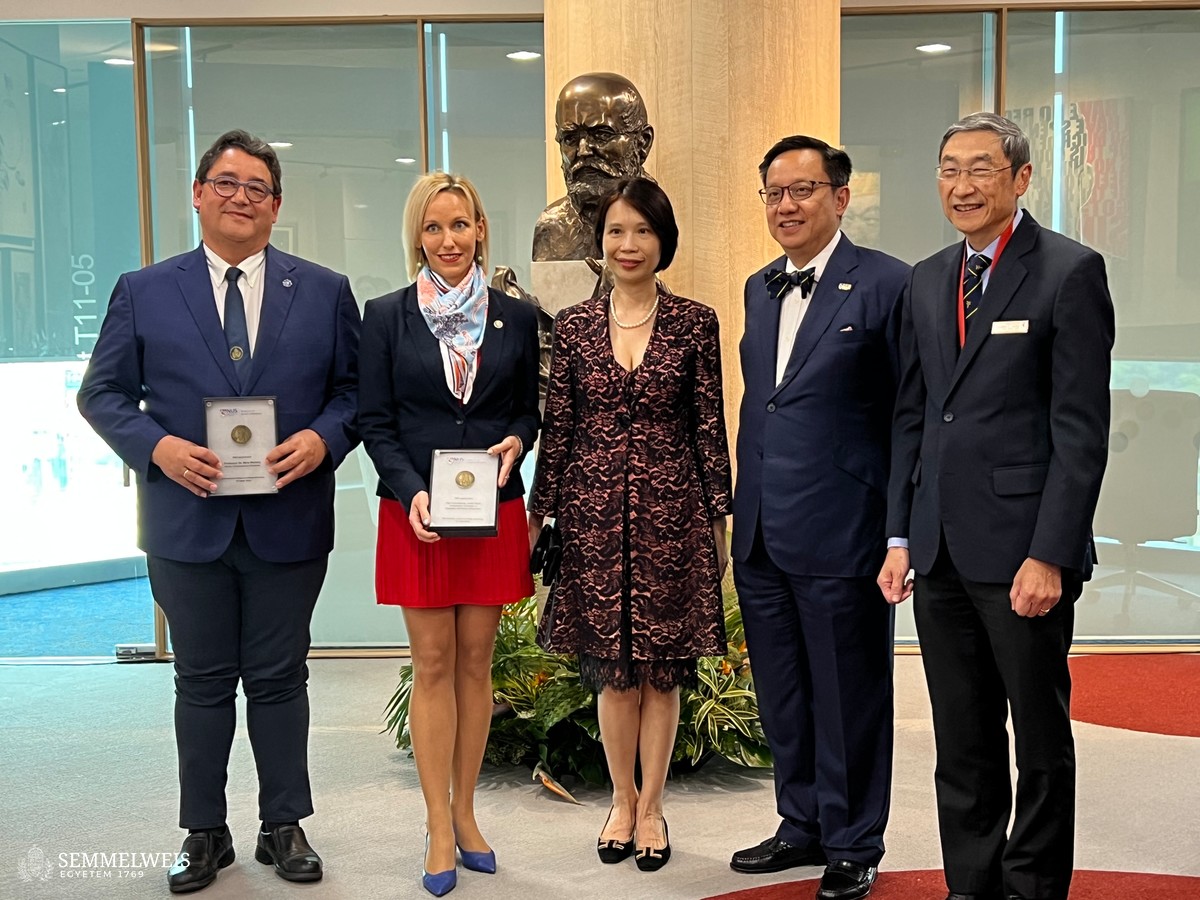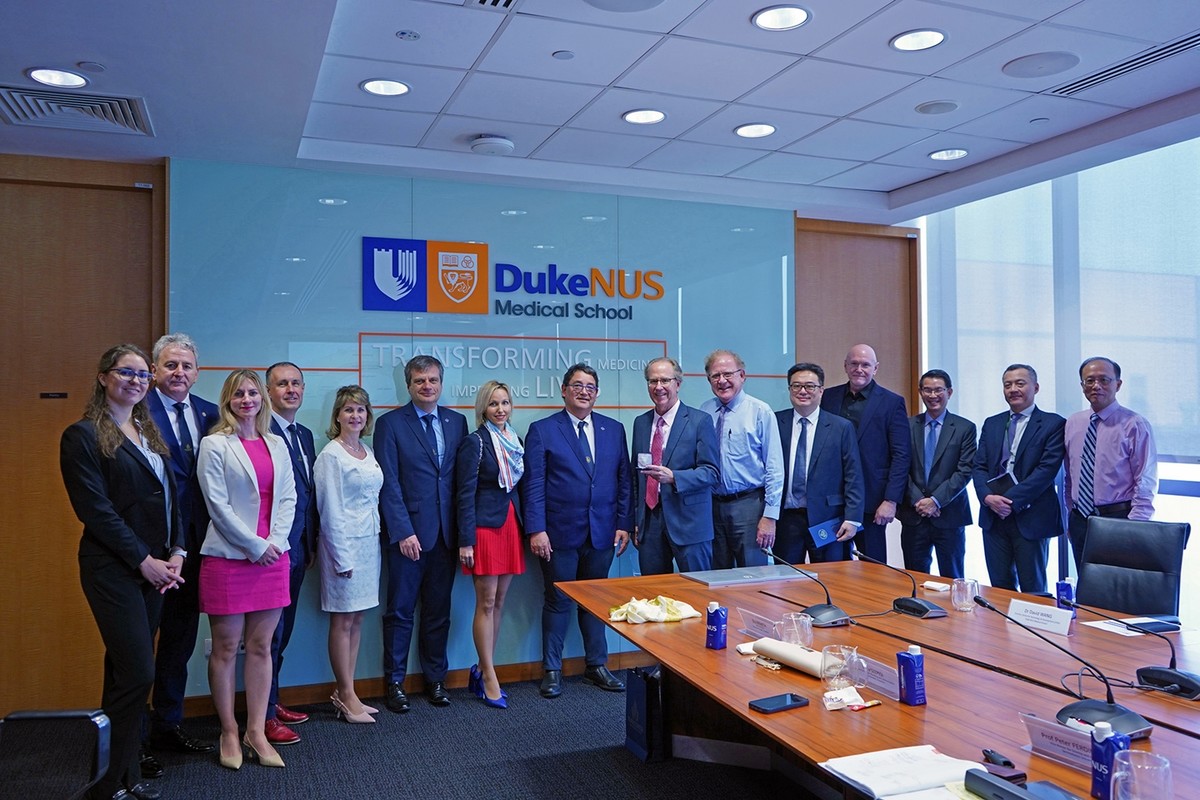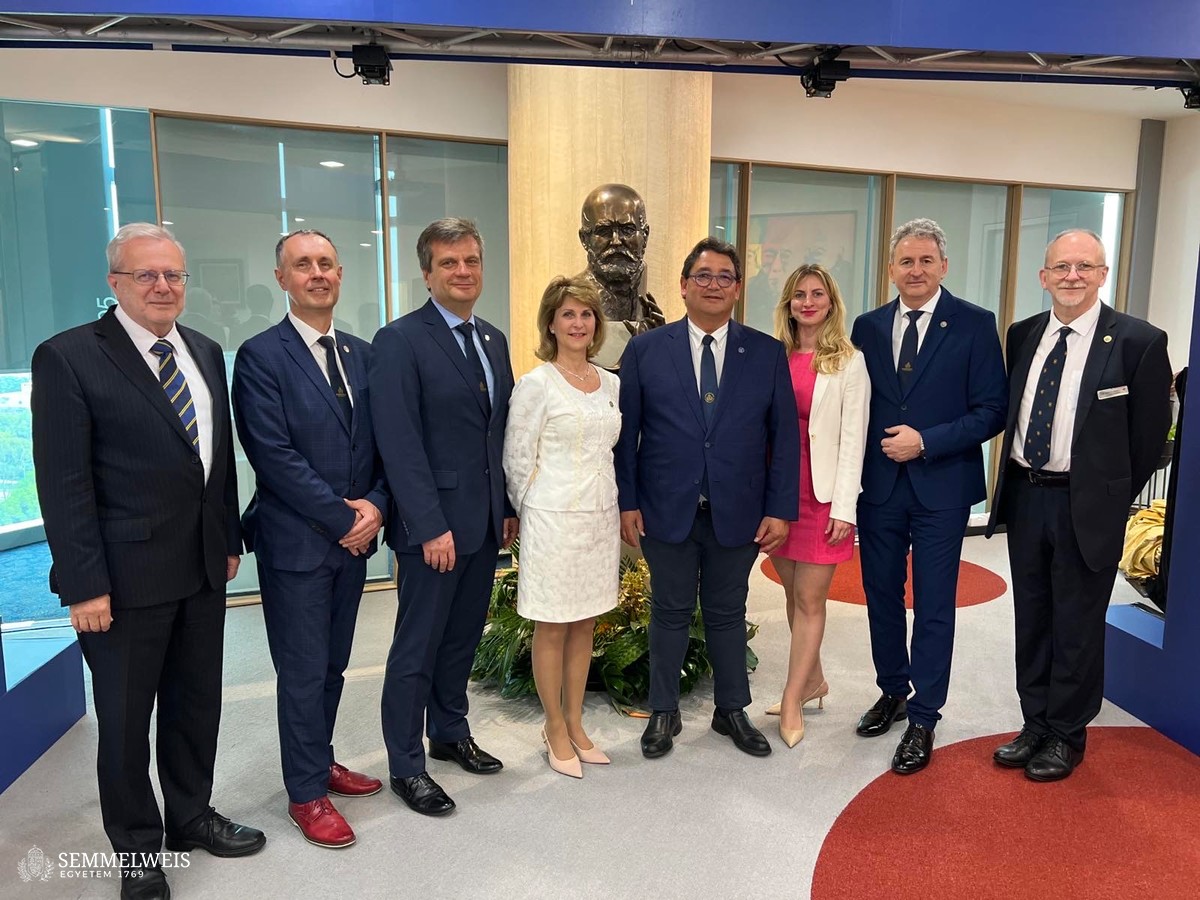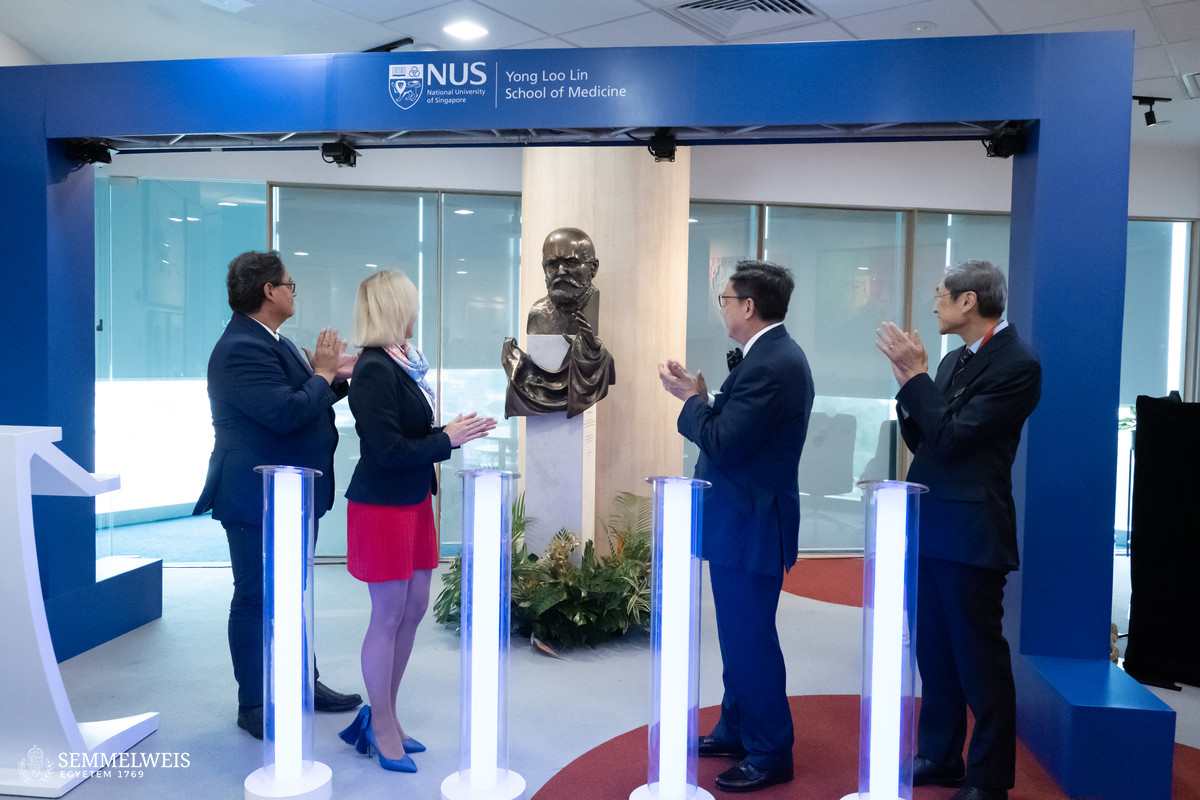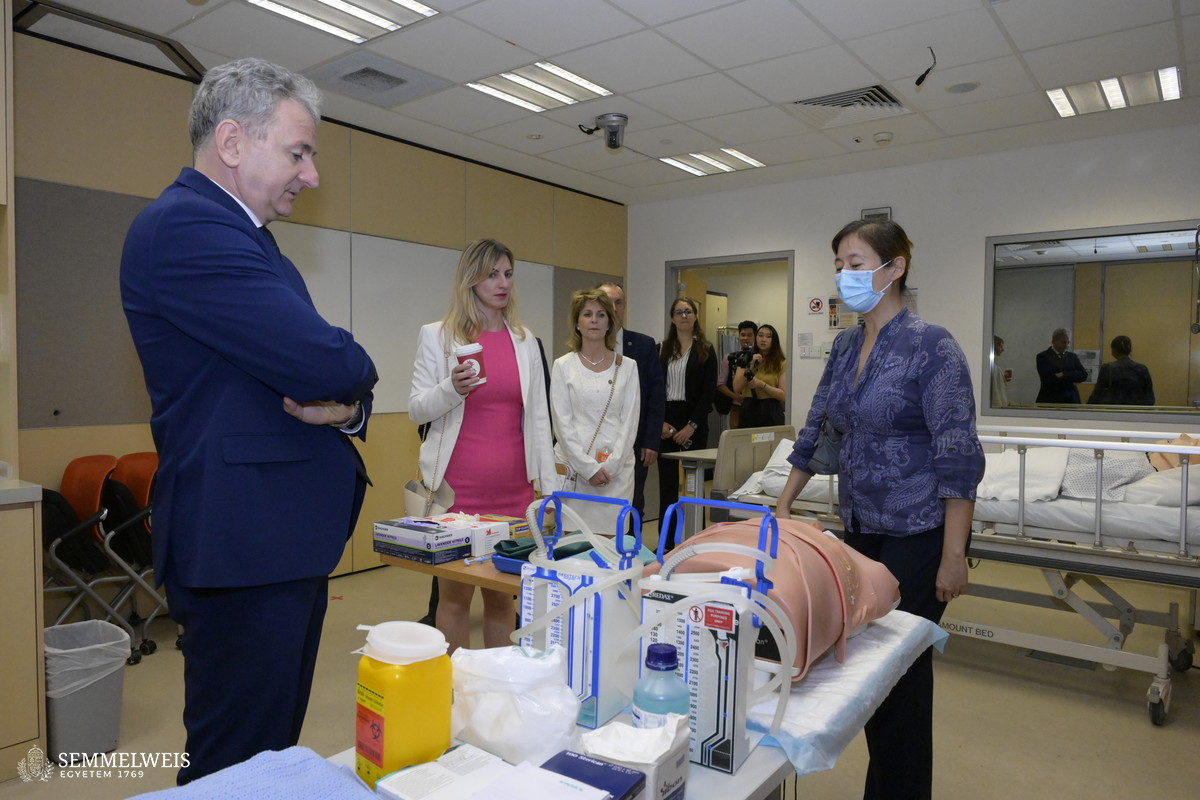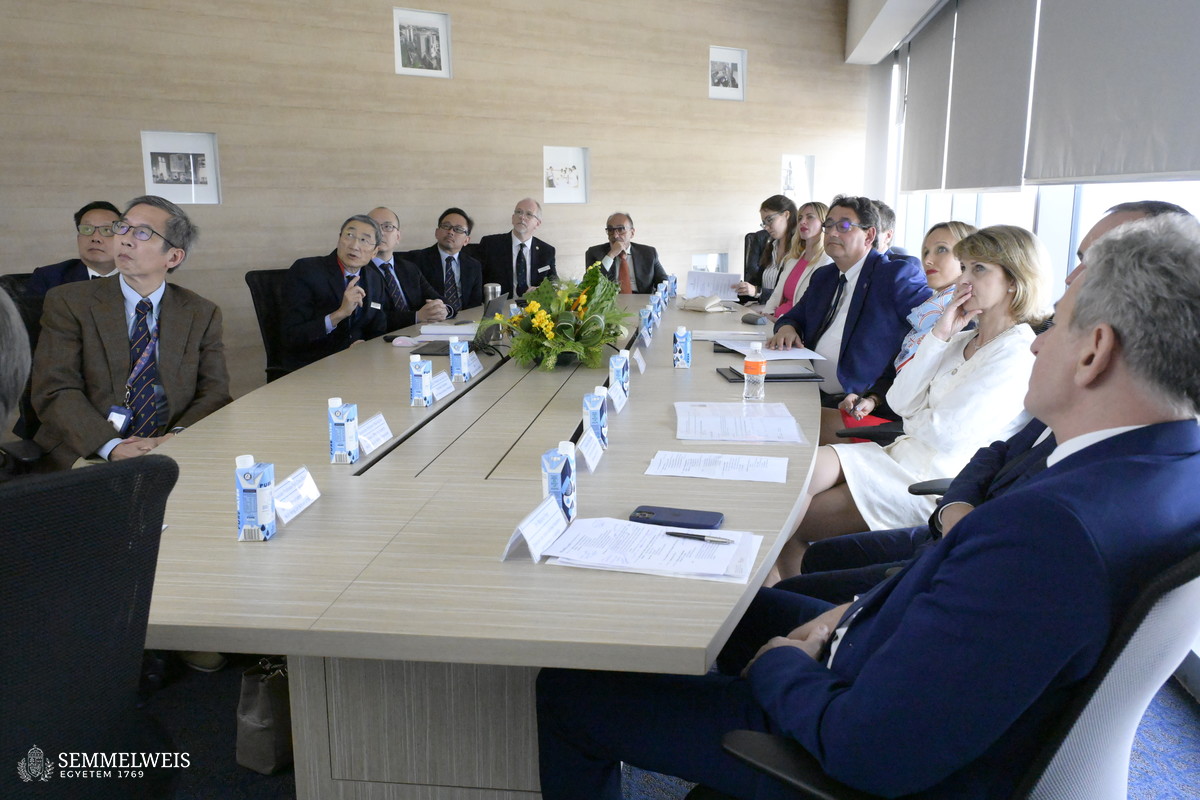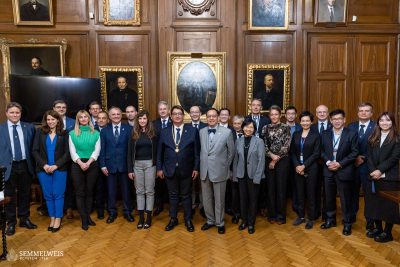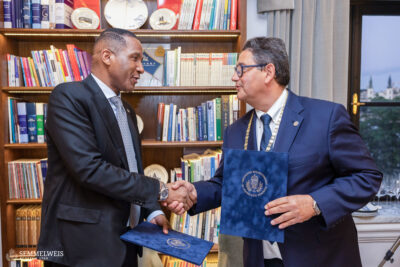As Dr. Béla Merkely pointed out, the overall aim of erecting such a statue is to preserve the legacy of Ignác Semmelweis, and pass it onto posterity. He reminded that ’the saviour of mothers’ made medical history by being the first to recognize the importance of and ways to prevent infections in obstetrics, and later in medical treatment in general. Over time, his discovery transformed medicine, and saved millions of lives through the change of attitude it brought about.
Semmelweis deserves his intellectual greatness to be duly celebrated, his memory cherished, and his message proclaimed throughout the world. That is why more than twenty similar statues commemorate Ignác Semmelweis on four continents around the globe. We are infinitely grateful to the leaders of the National University of Singapore (NUS) for being our partners in this mission
– the rector emphasized.
Dr. Béla Merkely went on to say that this is an excellent example of professional collaboration between the two universities. „The coordination of joint teaching and scientific work, the exchange of knowledge, the cooperation between lecturers and students has already started and joint research will soon be launched. All of these will ensure that our universities can work together more effectively, and compete more successfully with the world’s universities,” he said.
Judit Pach, the Hungarian Ambassador to Singapore reminded that it was one and a half year ago that they initiated this project in collaboration with fellow Hungarian scientists, namely Professor Balázs Gulyás, Director of the Cognitive Neuroimaging Centre (CoNiC) at the Lee Kong Chian School of Medicine, Nanyang Technological University (NTU), and Professor László Király, Head of Division and Senior Consultant at the Paediatric Cardiac Surgery at the National University Heart Centre of Singapore.
„From the first moment onwards, NUS President Tan Eng Chye confirmed his support for the Semmelweis statue, and we had the full backing of Semmelweis University and the Memorial Committee in Budapest led by Professor László Rosivall, who played a vital role in the realization of this project,” the ambassador stressed out.
„I believe that there is a lot of collaboration to come from this partnership, and also that the statue of Ignác Semmelweis, the first ever Hungarian statue erected in Singapore will contribute to the development of bilateral relations and can serve as a symbolic bridge between the two countries,” Judit Pach concluded.
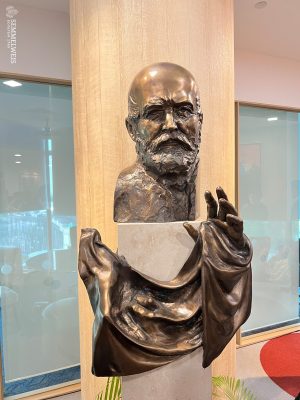 Professor Yap-Seng Chong, Dean of the Yong Loo Lin School of Medicine explained in his welcome address that it is not enough to simply produce knowledge; knowledge needs to be shared in order for other to build upon, challenge and elevate it. „This is why NUS Medicine is continuously looking to forge strong partnerships with many academic and scientific institutions around the world. We are fortunate to connect with Semmelweis University, an institution that aligns with our School’s vision to inspire health for all,” said the Dean at the ceremony, which was also reported by NUS.
Professor Yap-Seng Chong, Dean of the Yong Loo Lin School of Medicine explained in his welcome address that it is not enough to simply produce knowledge; knowledge needs to be shared in order for other to build upon, challenge and elevate it. „This is why NUS Medicine is continuously looking to forge strong partnerships with many academic and scientific institutions around the world. We are fortunate to connect with Semmelweis University, an institution that aligns with our School’s vision to inspire health for all,” said the Dean at the ceremony, which was also reported by NUS.
So far, the Semmelweis Memorial Committee has installed a total of 24 Semmelweis statues in Hungary and around the world. The works of 10 renowned sculptors, including 4 Kossuth Prize winners, and the inscriptions on the supporting column in English, Hungarian and local languages, proclaim the legacy and scientific truth of the legendary doctor for generations to come. Prior to the Singapore ceremony, a bronze bust in honour of Ignác Semmelweis was unveiled in London in January this year.
“It was a pleasure to represent Semmelweis University in Singapore, and the delegation was received with great respect and anticipation by Thomas M. Coffman, Dean of the Duke-NUS Medical School, faculty leaders and key researchers, as well as the President of the National University of Singapore, home of the bronze statue of Ignác Semmelweis, Professor Tan Eng Chye, Vice President John Eu-Li Wong, Chong Yap Seng, Dean of the NUS Yong Loo Lin School of Medicine, faculty leaders and researchers,” said Dr. Lívia Pavlik, Chancellor of Semmelweis University to our website. As she said, meaningful and useful discussions took place with the leaders of NUS and the delegations of both medical faculties regarding the structure of the curriculum and teaching methodology issues, the main topic being the possibility of enhancing common research areas. She added that they also gained useful experience for the changing higher education admissions system by gaining insight into the local oral examination process during their stay. “The NUS provides its students with a highly practical training, led by real-world workforce needs, where student progression is successfully achieved with minimal drop-out. This is greatly aided by excellent infrastructure, where both the theoretical and practical aspects of education are delivered to a high standard. We had the opportunity to take a campus tour of the skill labs and flagship core facilities, which provide state-of-the-art equipment for training and research activities. We met enthusiastic university colleagues at each site, who spoke with motivation and enthusiasm about their work at the institution. The NUS can be a worthy partner for Semmelweis University and can greatly support our international integration and growth of reputation,” the Chancellor said.
The name of Ignác Semmelweis is known everywhere, and as Hungarians, it makes us proud in this remote part of the world. The sculpture is a beautiful piece of art, worthy of Ignác Semmelweis as a person and doctor; it demonstrates that recognizing the importance of the smallest things can lead to the greatest discoveries, with a world-changing and generational impact
– said Dr. Lívia Pavlik. She added that Dr. Balázs Gulyás and Dr. László Király, who work in Singapore and were also present at the ceremony, played an important role in preparing the placement of the statue. They invited the university delegation to visit Nanyang Technological University. Semmelweis University representatives were also able to get closer to the startup world in Singapore, with the help of a data science company with Hungarian founders, through which they learned about the interface of big data and smart data in the industrial, healthcare and service sectors. “It has been an intense three-day professional program, with the hope that there is openness and commitment from both sides to share joint research and education experiences and achieve success in the future,” concluded the Chancellor.
Dr. Attila Szabó, Vice-Rector for Clinical Affairs told our website that several useful, forward-looking discussions were held and a number of research and educational collaborations were outlined.
I had the chance to participate in the oral entrance exam of the NUS Faculty of Medicine, which was a very valuable experience, as the oral entrance exam will be introduced at Semmelweis University from 2024. The main criteria were not the applicants’ professional knowledge, biological, chemical or physical skills, but their personal attitude, their ability to make decisions and cope with stress, and their ability to work in a team. To evaluate these, they used seven rounds of questions for which there is no right or wrong answer, as these tests are more about their various personal skills
– explained the Vice-Rector. Dr. Attila Szabó added that not only the participation in the entrance exams was a useful experience, but also the opportunity to get to know the exam’s topics, program and logistics.
The delegation from Semmelweis University was welcomed by the Duke-NUS management as part of an orientation visit, during which they were introduced to the university’s operations, curriculum, current research areas and the National Heart Research Institute Singapore (NHRIS). Founded in 2005 in partnership with the NUS and Duke University in the US, it is one of the top medical schools in the world, enrolling 72 students per year in its four-year program, in a bid to provide the highest quality of training. Semmelweis University has a joint collaboration with the institution, and the university’s Doctor Honoris Causa award winner, Dr. Derek J. Hausenloy, will help to further expand research collaborations.
After the presentations of Duke-NUS, Dr. Péter Ferdinandy, Vice-Rector for Science and Innovations introduced Semmelweis University, and then discussions on possible collaborations in the future between the two institutions began under the leadership of Rector Dr. Béla Merkely. After the official program, Dean Thomas M. Coffman invited the delegation to lunch, where discussions continued in a more informal setting, and gave way to further professional meetings during the Hungarian delegation’s stay. The official program continued at the main Medical Faculty of the NUS, where the campus tour included visits to the Museum of Anatomy, the Health Simulation Centre, the Clinical Imaging Research Centre and the Cardiology Centre.
The National University of Singapore (NUS) signed a memorandum of understanding with Semmelweis University in November last year, following the participation of NUS delegates at the Semmelweis Symposium, the university’s most prestigious international scientific event. The memorandum of understanding covers a wide range of areas, and is expected to help improve the international visibility and scientific output of both institutions. Among other things, the NUS would like to set up a professorial fellowship program which would be funded from their side, and the two universities would like to cooperate in the exchange of students and lecturers as well. In addition to the signing of the exchange agreement, the areas of cooperation have already been identified in which researchers from the two universities will work together.
The National University of Singapore (NUS) was founded in 1905 and is recognized as one of the leading higher education institutions in the Asia-Pacific region. It plays a key role in the development of modern technology, science, education and research, offering undergraduate and postgraduate programs in a wide range of disciplines (medicine, dentistry, the arts, social sciences, law, computer science, music). The university currently has almost 36,000 students and more than 2500 lecturers.
Viktória Kiss
Photo: National University of Singapore (NUS)
